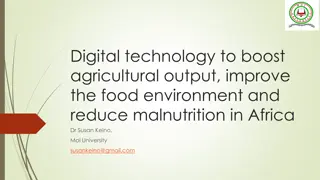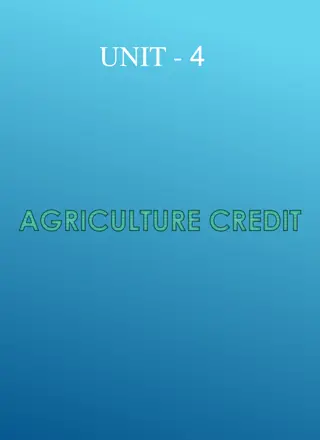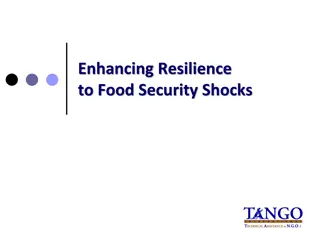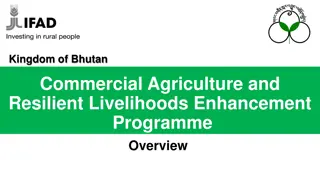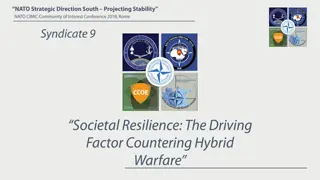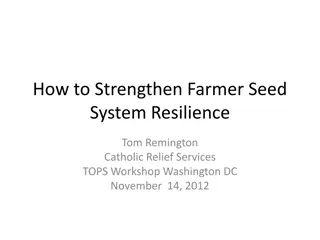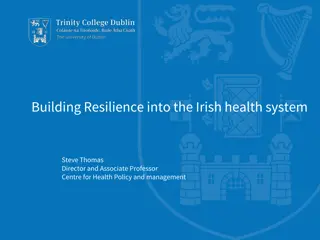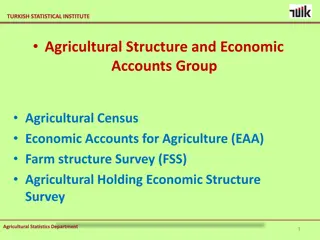Strengthening Data Systems for Agricultural Resilience in Africa
This report explores the modernization of agricultural statistics systems in Africa to inform policies aimed at enhancing resilience in agriculture, nutrition, and food security. It delves into the history and evolution of agriculture in Mauritius, focusing on the crop and livestock sectors, poultry production, trade dynamics, and self-sufficiency in various food categories. The data presented sheds light on the current state and potential areas for growth within the agricultural sector of Mauritius.
Download Presentation

Please find below an Image/Link to download the presentation.
The content on the website is provided AS IS for your information and personal use only. It may not be sold, licensed, or shared on other websites without obtaining consent from the author. Download presentation by click this link. If you encounter any issues during the download, it is possible that the publisher has removed the file from their server.
E N D
Presentation Transcript
Strengthening data systems by modernising the production and use of agricultural statistics: informing policies with a view to improving resilience in agriculture, nutrition and food security in Africa Ms. M. Dookhan FAREI
History and Evolution of Agriculture The sugar cane industry has been the backbone of our economy until recently. The agricultural sector of Mauritius comprise mainly of: Crop Sector Sugar cane Tea Food Crops Orchards Agriculture in the local context Ornamentals Livestock Sector Poultry Cattle Sheep and Goats Pigs Deer Food Processing Sector Fisheries sector D
Crop Sector Area harvested and production - Island of Mauritius, 2019 - 2020 2020 1 2019 Crops Area harvested (hectares) Production (tonnes) Area harvested (hectares) Production (tonnes) Sugar cane 45,054 3,405,250 43,711 2,620,874 Agriculture in the local context 656 2 667 2 Tea (green leaves) 8,329 5,105 Foodcrops 7,334 93,736 7,352 95,029 Source: Statitistics Mauritius 1 Provisional 2 Area under cultivation
Livestock Sector Number of cattle, goats, sheep and pigs by type of breeder as at December 2021 - Island of Mauritius Type of breeder Cattle Goats Sheep Pigs Agriculture in the local context Small breeders 2,964 20,768 3,929 16,570 Livestock breeding stations and prisons farm 143 235 50 - Large commercial farms 627 1,139 1,055 5,852 TOTAL 3,734 22,142 5,034 22,422 Source: FAREI
Poultry The Republic of Mauritius is self-sufficient in chicken meat and eggs Yearly production: 47,500 t of chicken meat 12000 t of eggs (equivalent to 218.2 million units) Agriculture in the local context Number of birds and number of farmers as at December 2021 Broilers Layers No. of farmers No. of Birds 354 145 1,944,968 557,376 Source: FAREI
Trade Imports The Rep. of Mauritius relies on imports of its staple food (rice, wheat), meat, milk and milk products, pulses and other cereals Onion and Potato are imported during off season to cater for market demand Self sufficiency of food is below 30% Exports Sugar is a main agricultural export (368,407 t) Other exports include: wheat flour (10,167 t), fish (83,617 t), pineapple (1,228 t) and other fruits (238 t) Agricultural Trade in the local context Self-sufficiency The Republic is self-sufficient in most fresh vegetables Local Fruits: Banana, pineapple, watermelon Chicken and Venison; eggs.
Food Security at a glance
Food security exists when all people, at all times, have physical and economic access to sufficient, safe and nutritious food that meets their dietary needs and food preferences for an active and healthy life (World Food Summit, 1996) The right to food was first recognized in the UN Declaration of Human Rights in 1948 For food security to exist, the following conditions should be met: Food Security at a glance Food Availability Food Access Utilisation of food Stability
The state of Mauritius should cater for food security for: A population of around 1.3 million The visitors Prior to the COVID-19 pandemic, there were around 1.4 million people visiting yearly and spending approximately 10 nights. Food Security for the Republic of Mauritius
Policy decisions are crucial to the achievement or maintenance of Food Security Policy decisions should most preferably be data-driven. Statistical analysis can assist decision makers identify issues. Therefrom, appropriate measures can be taken. Statistics analysis can be used as a forecasting tool. Decisions can be taken to avert or reduce a predicted negative impact. Importance of informed policies Statistics can help in the monitoring and evaluation of policies. If need be, new or altered policies/schemes/grant could thus be developed.
Good Statistics can enhance the decision making process as regards to: New schemes (e.g. encouraging production of specific crops) Release of land for crop/livestock production Importations to cater for low market supply Importance of informed policies Storage facilities Transformation and preservation of agricultural products
Agricultural statistics are crucial to inform decisions that will drive a more sustainable agriculture. These are the necessary qualities of Agricultural Statistics: Timeliness Accuracy Reliability How can agricultural statistics help to combat food insecurity? They are key to: Enhance productivity Decrease food loss and waste Forecast food shortages, crisis Informed decision making for imports Combat malnutrition
Productivity can be enhanced by making available: Yield data Data on diseases/disease resistance Meteorological data Soil fertility data New techniques of production (e.g. vertical farming) Cost of production data A decrease in Food loss/ waste is possible by making available: How can agricultural statistics help to combat food insecurity? Pest and disease surveillance data New plantation data (to reduce glut) Market information data Forecast on food shortages can be worked out based on: Field survey data Remote sensing data (satellite or drone)
Class of users of Agricultural Statistics: Institutions and Authorities Decision makers Farmers Other Stakeholders Capacity building of data users as regards to data interpretation is important Data users
Data are produced by different institutes and by different sectors mainly for their own use Essential statistics from different institutions and sectors are published by Statistics Mauritius Statistics at Institutional level Strengthening data system involve cooperation between different institution
Stakeholders of interest that cut across the different sectors The MAIFS and other bodies falling under its purview FAREI Agricultural Services Mauritius Meat Authority Ministry of Blue Economy, Marine Resources, Fisheries and Shipping The Mauritius Meteorological Services Statistics Mauritius The Mauritius Chamber of Agriculture Stakeholders of interest The MCIA & The MSIRI Ministry of Environment Ministry of Finance
A need for more cooperation between stakeholers Statistics Mauritius is the local coordinator for statistics Cooperation between institutions generating statistics is essential for national benefit Benefits of cooperation include: Access to new data sources Increased efficiency Supporting data-driven decision-making towards the goal of food security Partnership for data- driven decisions
Crucial data needed in Agricultural statistics to support Food Security include (but is not limited to): Climate data Pest and Disease surveillance data Vulnerability assessment data Market data Land use data Soil fertility data Health care data (e.g. rate of chronic diseases, obesity, malnutrition in population) Government schemes Data of interest
Ways of improving resilience in Agriculture: Provide timely and evidence-based food security and livelihood information and analysis Targeting of vulnerable groups Identify needs of the targeted population and providing support needed Provide statistical support in areas such as survey design, sampling techniques and information management (data collection, data management, analysis and dissemination) Increase granularity of data Capacity building for data users and data producers Expand the capabilities of partners engaged in food security Raise awareness on food security situation Improving Resilience in Agriculture
Modernising data collection and production of agricultural statistics Use of the likes of smart phones and tablet for data collection purposes Using new technological improvements (e.g. remote sensing) to collect data. The integration of data from different sources (e.g. survey data vs. master sampling frames, big data etc.), Using GIS technologies to visualise field data on a map Modernising the production and use of Agricultural Statistics Using Big Data to reveal patterns, trends, and associations amongst others. They are mostly used in developed countries due to their complexities. Producing new indicators in response to the growing demand by policy-makers and decision makers for statistics based information that is interlinked in different aspects agricultural, social, economical, environmental, etc.
Application of the modern technologies can help in: Digitalising data and creating of repositories Dissemination of information and raising of awareness Providing support to vulnerable groups and vulnerable farmers Identifying, quantifying and monitoring vulnerable regions (mountain flanks, flood prone regions) Raise awareness on food security situation Planning of production to high accuracy using modern techniques of production thus avoiding market glut. Modernising the production and use of Agricultural Statistics
Modern agriculture will become more significant in the future to feed the nation and this can be facilitated through enhancing our agricultural statistics system for better production with optimal cost to serve market demand. Concluding Remarks






